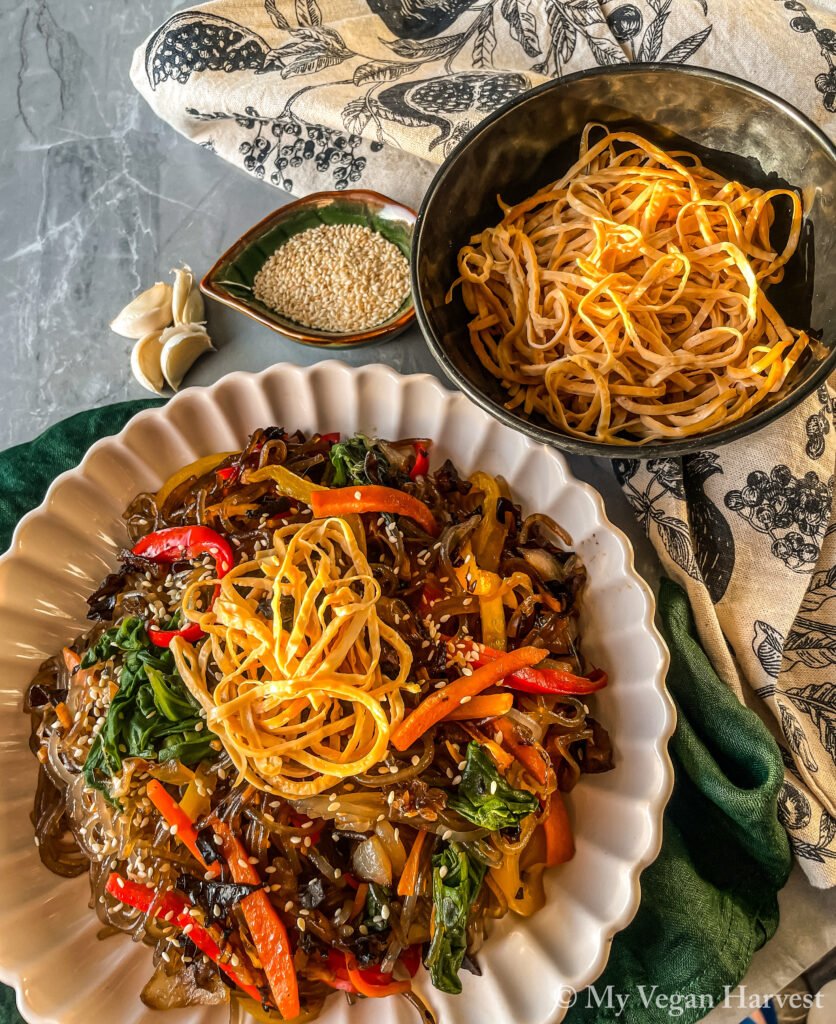Vegan Japchae (Korean Glass Noodles With Stir-Fried Vegetables)
What is Vegan Japchae?
VEGAN JAPCHAE or CHAPCHAE is a sweet and savory Korean dish that will delight both the eyes and the palate with its chewy stir-fried potato starch glass noodles (dangmyeon) mixed with a gorgeous and colorful array of tender-crisp vegetables.

Why Cook Japchae?
DID YOU KNOW that japchae was considered a royal dish in the early 17th century and originally did not include any noodles? According to an article published by the Korea Tourism Organization (2017), this was first made for King Gwanghaegun’s palace banquet and became a luxurious dish that was served to the royal family and other high-level officials.
In the present, it is one of the most popular dishes in Korean cuisine and is traditionally cooked with potato starch glass noodles, stir-fried meat, mushrooms, and vegetables like carrots, onions, and spinach. Since then, the recipe has evolved, but the beauty of this dish remains the same.

Japchae is commonly served during celebrations and festive holidays, but it can definitely be enjoyed as an everyday dish. Although this recipe is vegan and therefore not traditional, the combination of flavors and ingredients in this is still incredibly good and will leave you craving more!
This is my go-to recipe when I’m cooking for my loved ones because it is so easy to prepare, has simple ingredients, and is a definite crowd-pleaser. I also discovered a secret ingredient for the classic vegan egg garnish (jidan) in traditional japchae! View the recipe card in this post to see what it is!

how to cook this delicious Vegan Japchae
Vegan Japchae (Korean Glass Noodles with Stir-Fried Vegetables)
Ingredients
Method
- Cook the dried black fungus in boiling water for 20 to 30 minutes (or until it has softened). Roughly chop into bite-size pieces. Set aside.
- For the jidan, cook the sliced tofu skin in boiling water for 10 minutes. Drain and let it cool. (TIP: You may add a pinch of black salt or kala namak to replicate the eggy taste). Set aside.
- Put the glass noodles into boiling water with a little salt and let it boil for at least 10 minutes (may vary according to packaging instructions). Once it is cooked, drain the noodles and mix with a tablespoon of sesame oil and a pinch of salt. Set aside in a bowl.
- To blanch the spinach, bring a pot of water to boil. Cook the spinach in the boiling water for 30 seconds. Once it has wilted and has turned into a bright green color, remove it with a slotted spoon and submerge it into a bowl with ice and water for at least 1 minute then drain (this step helps preserve its bright color and texture). Drain and gently squeeze out the excess water from the spinach. Set aside.
- Mince the garlic. Thinly slice the onion. Slice the carrot and bell peppers into julienne strips.
- In a small and dry frying pan, toast the white sesame seeds until it turns fragrant and golden in color. Let it cool and set aside. Now we are ready to start cooking japchae! YAY!
- In a large non-stick pan, sauté the garlic and sweet onion with oil until it is aromatic. Add the wood ear mushrooms and stir fry for at least 2 minutes over medium heat.
- Add the strips of carrot and bell peppers into the pan and stir fry for a few minutes, but be careful not to overcook it. We want the vegetables to be cooked with a tender-crisp texture.
- Add the noodles into the pan and mix in with the sauce and other ingredients (spinach and tofu skin).
- Serve hot on a plate and garnish with the sliced tofu skin and toasted white sesame seeds.
Notes
Historical Info Reference:
- Korea Tourism Organization. (2017, February 21). Exploring Korea’s true flavor. https://web.archive.org/web/20170319034327/https://korea.stripes.com/news/exploring-korea%E2%80%99s-true-flavor#sthash.js8IWn0c.dpbs
